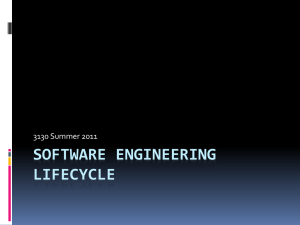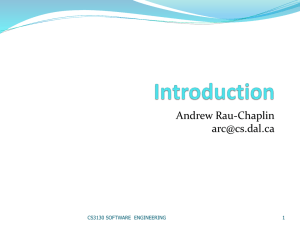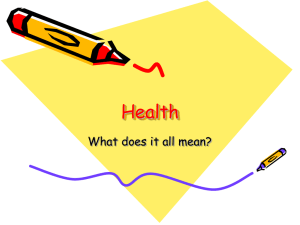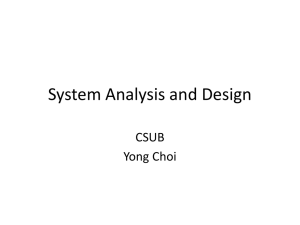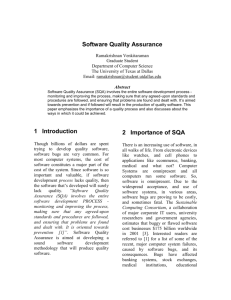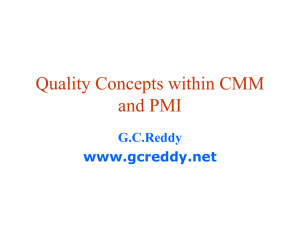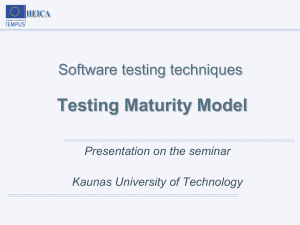Software engineering lifecycle
advertisement
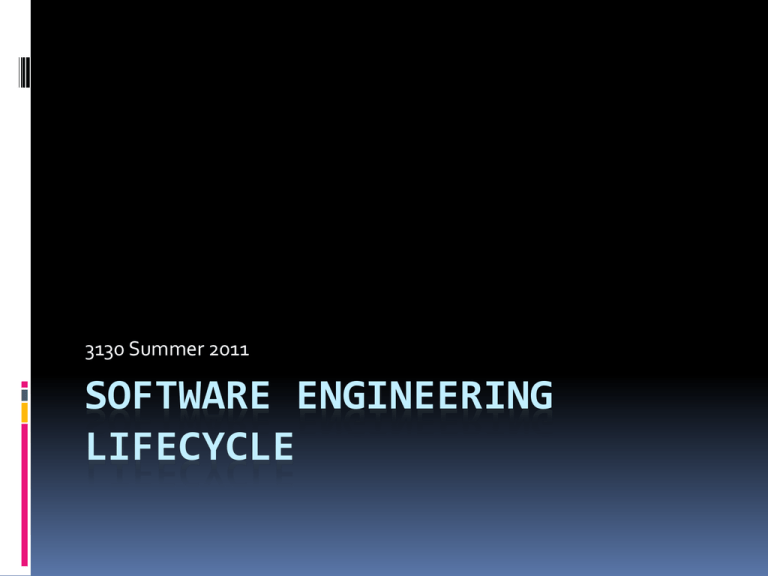
3130 Summer 2011 SOFTWARE ENGINEERING LIFECYCLE What is Software? Software (IEEE) is a collection of programs, procedures, rules, and associated documentation and data CS3130 SOFTWARE ENGINEERING – Summer 2011 2 Software Q : If you have to write a 10,000 line program in C to solve a problem, how long will it take? Answers: generally range from 2-4 months Let us analyze the productivity Productivity = output/input resources In SW output is considered as LOC Input resources is effort - person months; overhead cost modeled in rate for person month Though not perfect, some productivity measure is needed, as project has to keep it high CS3130 SOFTWARE ENGINEERING – Summer 2011 3 Software … The productivity is 2.5-5 KLOC/PM Q: What is the productivity in a typical commercial SW organization ? A: Between 100 to 1000 LOC/PM Q: Why is it low, when your productivity is so high? (people like you work in the industry) A: What the student is building and what the industry builds are two different things CS3130 SOFTWARE ENGINEERING – Summer 2011 4 Software… Students build: student software Industry builds: industrial strength Systems What is the difference between student software and industrial strength software for the same problem? CS3130 SOFTWARE ENGINEERING – Summer 2011 5 Software… Student Developer is the user Industrial Strength Others are the users Works for the typical Works robustly case most of the time Bugs are tolerable UI not important No documentation Bugs not tolerated UI very important issue Documents needed for the user as well as for the organization and the project CS3130 SOFTWARE ENGINEERING – Summer 2011 6 Software… Student SW not in critical use Reliability, robustness not important No investment Don’t care about portability Industrial Strength Supports important functions / business Reliability , robustness are very important Heavy investment Portability is a key issue here CS3130 SOFTWARE ENGINEERING – Summer 2011 7 Industrial Strength Software Student programs != industrial strength software Key difference is in quality (including usability, reliability, portability, etc.) High quality requires heavy testing, which consumes 30-50% of total development effort Requires development be broken in stages such that bugs can be detected in each Good UI, backup, fault-tolerance, following of stds etc all increase the size for the same functionality CS3130 SOFTWARE ENGINEERING – Summer 2011 8 Industrial strength software If 1/5th productivity, and increase in size by a factor of 2, industrial strength software will take 10 times effort Brooks thumb-rule: Industrial strength SW costs 10 time more than student SW In this course, software == industrial strength software CS3130 SOFTWARE ENGINEERING – Summer 2011 9 Software is Expensive Rough cost estimate… Productivity = 500 LOC/PM Cost to the company = $10K/PM Cost per LOC = $20 So each line of delivered code costs about $20. A simple application for a business may have 20KLOC to 50KLOC Cost = $100K to $1Million Can easily run on $10K-$20K hardware So HW costs <<< SW costs. CS3130 SOFTWARE ENGINEERING – Summer 2011 10 Software is Expensive… The HW/SW ratio for a computer system has shown a reversal from the early years. In 50s , HW:SW :: 80:20 In 80s , HW:SW :: 20:80 So, SW is very expensive Importance of optimizing HW is not much More important to optimize SW CS3130 SOFTWARE ENGINEERING – Summer 2011 11 Late & Unreliable 20-25% of SW projects never complete Because after some time they realize that the final cost will be much higher Many companies report “runaways” Budget & cost out of control Consulting companies to help control them One defense survey found that 70% of the equipment problems are due to SW CS3130 SOFTWARE ENGINEERING – Summer 2011 12 Why is SW Unreliable? SW failures are different from failures of mechanical or electrical systems In software, failures are not due to aging related problems Failures occur due to bugs or errors that get introduced during development The bug that causes a failure typically exists from start, only manifests later CS3130 SOFTWARE ENGINEERING – Summer 2011 13 Maintenance Once SW delivered, it enters maintenance phase Why is maintenance needed for SW when it does not wear with age? Residual errors requiring corrective maintenance Upgrades and environment changes – adaptive maintenance Over SW lifetime, maintenance can cost more than the development cost of SW CS3130 SOFTWARE ENGINEERING – Summer 2011 14 What is Software Engineering? Problem domain discussed before, now we discuss the area of SE SE (IEEE): systematic approach to development [….] of software Systematic approach: methodologies and practices that can be used to solve a problem from problem domain CS3130 SOFTWARE ENGINEERING – Summer 2011 15 Basic Problem CS3130 SOFTWARE ENGINEERING – Summer 2011 16 SE Challenges The problem of producing software to satisfy user needs drives the approaches used in SE Q: What other factors that drive the selection of a SE approach? 1. scale, 2. productivity, 3. quality, 4. consistency, 5. rate of change, … CS3130 SOFTWARE ENGINEERING – Summer 2011 17 1) Scale SE must deal with problem of scale methods for solving small problems do not scale up for large problems industrial strength SW problems tend to be large SE methods must be scalable Two clear dimensions in this 1. engineering methods 2. project management For small, both can be informal or ad-hoc, for large both have to be formalized CS3130 SOFTWARE ENGINEERING – Summer 2011 18 1) Scale… CS3130 SOFTWARE ENGINEERING – Summer 2011 19 1) Scale… An illustration of issue of scale is counting the number of people in a room vs taking a census Both are counting problems Methods used in first not useful for census For large scale counting problem, must use different techniques and models Management will become critical CS3130 SOFTWARE ENGINEERING – Summer 2011 20 1) Scale: Examples Gcc 980KLOC C, C++, yacc Perl 320 KLOC C, perl, sh Appache 100 KLOC C, sh Linux 30,000 KLOC C, C++ Windows XP 40,000 KLOC C, C++ CS3130 SOFTWARE ENGINEERING – Summer 2011 21 2) Productivity An enginerring project is driven by cost and schedule Cost: In sw, cost is mainly manpower cost; hence, it is measured in person-months Schedule is in months/weeks – very important in business context In Biz context Cost and Schedule can not be separated SE must serve the Biz, NOT the other way around CS3130 SOFTWARE ENGINEERING – Summer 2011 22 2) Productivity Productivity captures both Cost and Schedule If P is higher, cost is lower If P is higher, time taken can be lesser Approaches used by SE must deliver high Productivity CS3130 SOFTWARE ENGINEERING – Summer 2011 23 3) Quality Quality is the other major driving factor Developing high Quality SW is a basic goal Quality of SW is harder to define Approaches used should produce a high Quality software CS3130 SOFTWARE ENGINEERING – Summer 2011 24 3) Quality – ISO standard ISO standard has six attributes 1. 2. 3. 4. 5. 6. Functionality Reliability Usability Efficiency Maintainability Portability CS3130 SOFTWARE ENGINEERING – Summer 2011 25 3) Quality… Multiple dimensions mean that not easy to reduce Q to a single number Concept of Q is project specific For some reliability is most important For others usability may be more important Reliability is generally considered the main Q criterion CS3130 SOFTWARE ENGINEERING – Summer 2011 26 3) Quality… Reliability = Probability of failure Hard to measure Approximated by # of defects in software To normalize Quality = Defect density Quality = # of defects delivered / Size Defects delivered - approximated with no. of defects found in operation Current practices: less than 1 defect/KLOC What is a defect? Project specific! CS3130 SOFTWARE ENGINEERING – Summer 2011 27 4) Consistency and repeatability Sometimes a group can deliver one good software system, but not a second Key SE challenge: how to ensure that success can be repeated ? SE wants methods that can consistently produce high Quality SW with high Productivity A SW org, wants to deliver high Q&P consistently across projects Frameworks like Inter. Org. for Standardization (ISO) and Capability Maturity Model (CMM) focus on this aspect CS3130 SOFTWARE ENGINEERING – Summer 2011 28 5) Rate of Change Only constant in business is change! Software must change to support the changing business needs SE practices must accommodate change Methods that disallow change, even if high Q and P, are of little value CS3130 SOFTWARE ENGINEERING – Summer 2011 29 Goals of Industrial Strength Consistently develop SW with high Q&P for large SE scale problems, under change Q&P are the basic objectives to be achieved Q&P governed by people, processes, and technology CS3130 SOFTWARE ENGINEERING – Summer 2011 30 Iron Triangle CS3130 SOFTWARE ENGINEERING – Summer 2011 31 Iron Triangle What happens when you break the triangle? 1) The project gets canceled. 15% of projects are cancelled before they deliver a system. A study of 1,027 IT projects cited scope management related to serial practices as the single largest contributing factor to project failure in 82% of the projects and was given a overall weighted failure influence of 25%. www.ambysoft.com/essays/brokenTriangle.htm CS3130 SOFTWARE ENGINEERING – Summer 2011 32 Iron Triangle What happens when you break the triangle? 2) The Project is deliver late, over budget, or both According to the Chaos Report 51% of projects are challenged (severely over budget and/or late), with an average cost overrun of 43%. www.ambysoft.com/essays/brokenTriangle.htm CS3130 SOFTWARE ENGINEERING – Summer 2011 33 Iron Triangle What happens when you break the triangle? 3) The Project delivers poor quality software. When development teams are forced to deliver more functionality than they have time or resources for, they are often motivated to take short cuts which inevitably result in poor quality. www.ambysoft.com/essays/brokenTriangle.htm CS3130 SOFTWARE ENGINEERING – Summer 2011 34 Iron Triangle What happens when you break the triangle? 4) The project under delivers. The team fails to deliver all of the required functionality. www.ambysoft.com/essays/brokenTriangle.htm CS3130 SOFTWARE ENGINEERING – Summer 2011 35 Iron Triangle… What to do about it? Recognize that the iron triangle must be respected. So Vary the Scope Vary the Schedule Vary the Resources Vary two or more factors www.ambysoft.com/essays/brokenTriangle.htm CS3130 SOFTWARE ENGINEERING – Summer 2011 36 SE Methodology SE focuses mostly on processes for achieving the goals Process must be systematic SE separates process for developing sw from the developed product (i.e the sw) Premise: Process largely determines Q&P, hence suitable processes will lead to high Q&P CS3130 SOFTWARE ENGINEERING – Summer 2011 37 SE Methodology… Design of proper processes and their control is a key challenge SE faces Sw process is the equivalent of manufacturing process This focus on process makes SE different from many CS courses CS3130 SOFTWARE ENGINEERING – Summer 2011 38 SE Methodology… The development process used in SE is typically phased Phases separate concerns with each phase focusing on some aspect Requirements, architecture, design, coding, testing are key phases This phased process has to be properly managed to achieve the objectives Metrics and measurement important for this CS3130 SOFTWARE ENGINEERING – Summer 2011 39 “V” model http://www.harmonicss.co.uk/index.php/hss-downloads/doc_download/12-death-of-the-v-model Summary The problem domain for SE is industrial strength software Software comprises programs, documentation, and data SE aims to provide methods for systematically developing SW Main goal – achieve high quality and productivity (Q&P) CS3130 SOFTWARE ENGINEERING – Summer 2011 41 Summary… Must have high Q&P with consistency in the context of large scale and frequent changes Basic approach of SE is to separate process from products and focus on process and managing the process CS3130 SOFTWARE ENGINEERING – Summer 2011 42 PROCESS MANAGEMENT PROCESS Other Processes 43 Background A process is not a static entity – it has to change to improve to improve the Q&P Focus of process management is to evaluate and improve the process Is different from project management which focuses on a project Process management is an advanced topic Other Processes 44 Software Process Improvement To improve the process, an org must understand the current process Requires process be properly documented Properly executed on projects Data is collected from projects to understand the performance of process on projects Changes to process are best made in small increments Other Processes 45 Software Process Improvement Frameworks What changes should be made to the process and when Frameworks suggest ways of how process improvement can proceed Capability Maturity Model (CMM) is one of the most common frameworks Other Processes 46 CMM CMM has five maturity levels for a software process (level 1 is ad-hoc) In a level, process has some capabilities and lays the foundation for next level For moving from one level to another, CMM specifies areas to focus on Is used heavily by sw industry Other Processes 47 CMM Note: • Student projects: CMM level 1 (ad hoc) • SW Engg. Course Project: CMM level 2 Other Processes 48 Course Project Notes Decide on roles and responsibilities Possible Roles Project management & Change management process Web site, Charter & Feasibility Doc, SRS & Project Plan, Meeting minutes Design Lead High Level & Detailed Design Docs Development Lead Coordination of implementation efforts, system integration Configuration Management Lead Setup and management of version control and build system Quality Assurance & Testing Lead Test Docs, User manuals Software Process 49 Course Project Notes Set up the website and SVN (MS1) Project Charter Doc (MS2) Anchors a project helping the team avoid mid project drift. Every project needs a charter! If the sponsor doesn't provide it, the development team should create one and get it approved! See the Project Details document for templates. Software Process 50
